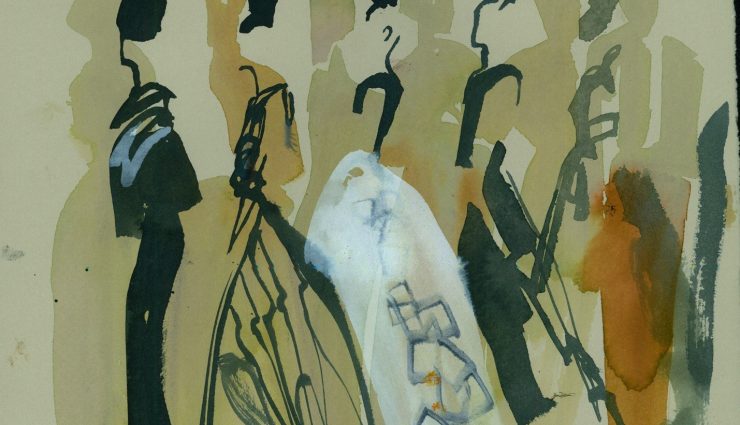
Fashion Portfolio + Story Telling + Emotional Connection
Illustration by Bil Donovan
As an expression of a designer’s creative vision, the portfolio is of unparalleled importance. A portfolio should represent a designer’s style, skills, work and experience. It should communicate his or her aesthetic sensibility and emotional story, doing so in a way that is current and relevant. Ultimately, it should – it must – impress.
So how can it accomplish this ambitious goal? A portfolio is just a book, right? Perhaps, but it’s a book that represents you as a creative professional–and in this sense It just may be the most important book in your life! Following are some key ideas I discuss with my students about creating an unforgettable portfolio.
WHAT IS A PORTFOLIO?
As with any creative endeavor it’s essential to understand the ultimate purpose of your portfolio, which should reflect your:
- Interests, style and taste level.
- Conceptual abilities, inspirational insight and thought process
- Research abilities, from historic or current fashion to lifestyle and market trends.
- Design style and sensibilities, from silhouettes, color, fabric, prints and textile surface design.
- Exploration, experimentation, manipulation and decoration on fabrics and forms.
- Knowledge of fashion history and clothing construction.
- Design and technical skills: illustration, flat sketches and computer skills.
Remember: The portfolio should only represent your strengths. For example, if your illustration skills are weak, find new ways to present concepts and ideas–experiment with other media.
THE PORTFOLIO BOOK: SIZE MATTERS
Don’t overlook the book itself. Remember, fashion is driven by aesthetics. When you hand your portfolio across a table, the book provides the first impression of who you are as a designer.
- High quality portfolio can last for years, look professional and protect one’s work.
- Size does matter for easy carrying and presentation.
- Flexibility: have protective sleeves that enable you to easily add or remove content; don’t leave blank pages.
HIGHLIGHTING YOUR RESEARCH AND CONCEPTUAL ABILITIES
Research methods show how you work. For example, are all research materials based on Internet images, fashion magazines and runway shows images? Or do they go further–using primary research and touching on a range of topics such as historic or current events, pop culture, technology and lifestyles.
- Design concepts should be creative and original; don’t take the easy route with obvious or superficial references or inspirations. Interpretation of research materials and inspiration ideas should be implemented throughout the design development process.
- Research should add to your understanding of the market and customer, showing employers that you understand and care about this essential aspect of design.
- Mood boards should be beautifully done with compelling images and emotions to convey your concepts. The content, the design, the imagery and the “story telling” should be relevant to current culture and fashion trends.
EXPOSING YOUR DESIGN PROCESS
Show development of an idea from concept to final collection.
- Well-organized thoughts: make it clear how you work as a designer.
- Select beautiful color palettes and appropriate fabrics for each story.
- Present at least 4 different but cohesive stories, well edited and captivating.
SHOWCASING YOUR ABILITY TO EXPERIMENT AND CREATING IDEAS
Add interest to your portfolio by using hand work to create design ideas that explore volume, texture and new forms.
- Illustrations should be paired with innovative fabric manipulations, embellishment ideas such as beading and embroidery, hand knit swatches, dying and printing techniques to show one’s artisanship.
- Experimentation with shapes and forms, 3D to 2D creative draping, and 4D design applications.
DEMONSTRATING YOUR TECHNICAL KNOWLEDGE
A “must have” for communication skills in the industry, combining everything you know.
- Technical sketches: beautiful, precise and clean flat sketches (by hand or computer) represent your ability to transfer design from concept to final garment, as well as your understanding of pattern making, garment construction and finishing.
- CAD skills: knowledge of Photoshop and Adobe Illustrator are essential to show print artwork, graphic designs, and other digital design applications and presentations.
- Tech Packs (optional depending on the nature of the design position): present the complete design into a detailed technical specification that is easily understood by any factory to follow and produce the prototype.
Finally, to show you are a well-rounded designer don’t limit content to fashion or apparel. Include accessories (shoes, bags) and lifestyle products as well–in this way you will be creating the “Total Work of Art.”
 David Leung
David Leung
Fashion Portfolio Coach
Websites: www.fashionportfoliocoach.com and www.davidleung.nyc
E Mail: david@davidleung.nyc
Having spent over 20 years as a designer and creative director in the fashion industry, David Leung has extensive experience in all phases of design, product development, marketing and branding. Born in Hong Kong and educated in the United States, he has a global perspective that has grown through assignments in Milan, Paris and New York City. He has been a creative force behind such fashion houses as Versace, Sonia Bogner, Maska, Caractere, Joan & David, Magaschoni, Zoran and Natori.
David has reviewed and critiqued hundreds of fashion designers’ portfolios throughout his design career. As a design instructor at various fashion institutes, and when teaching “Fashion Portfolio” classes, he has guided students and fashion designers to conceptualize, create, improve and update their portfolios. David obtained his MA in Visual Culture: Costume Studies at New York University, his AAS in Fashion Design at the Fashion Institute of Technology, and his BS in Fashion Design & Merchandising at the University of Hawaii.
